Organizational Structure and Behavioral Change Management Report
VerifiedAdded on 2022/10/07
|9
|1617
|39
Report
AI Summary
This report delves into the multifaceted concept of organizational change, examining its impact on company management and performance. It explores the significance of structural changes, such as redefining authority and management systems, and process-oriented improvements aimed at optimizing workflows. The report also highlights person-centered changes, focusing on employee behavior, motivation, and skill development. It references the theory of cognitive dissonance and the application of behavioral psychology to organizational settings, emphasizing the importance of consistent management strategies and the role of role models in driving sustainable change. The report concludes by stressing the need for a holistic approach that considers the interconnectedness of these various change types to achieve lasting improvements in organizational performance.
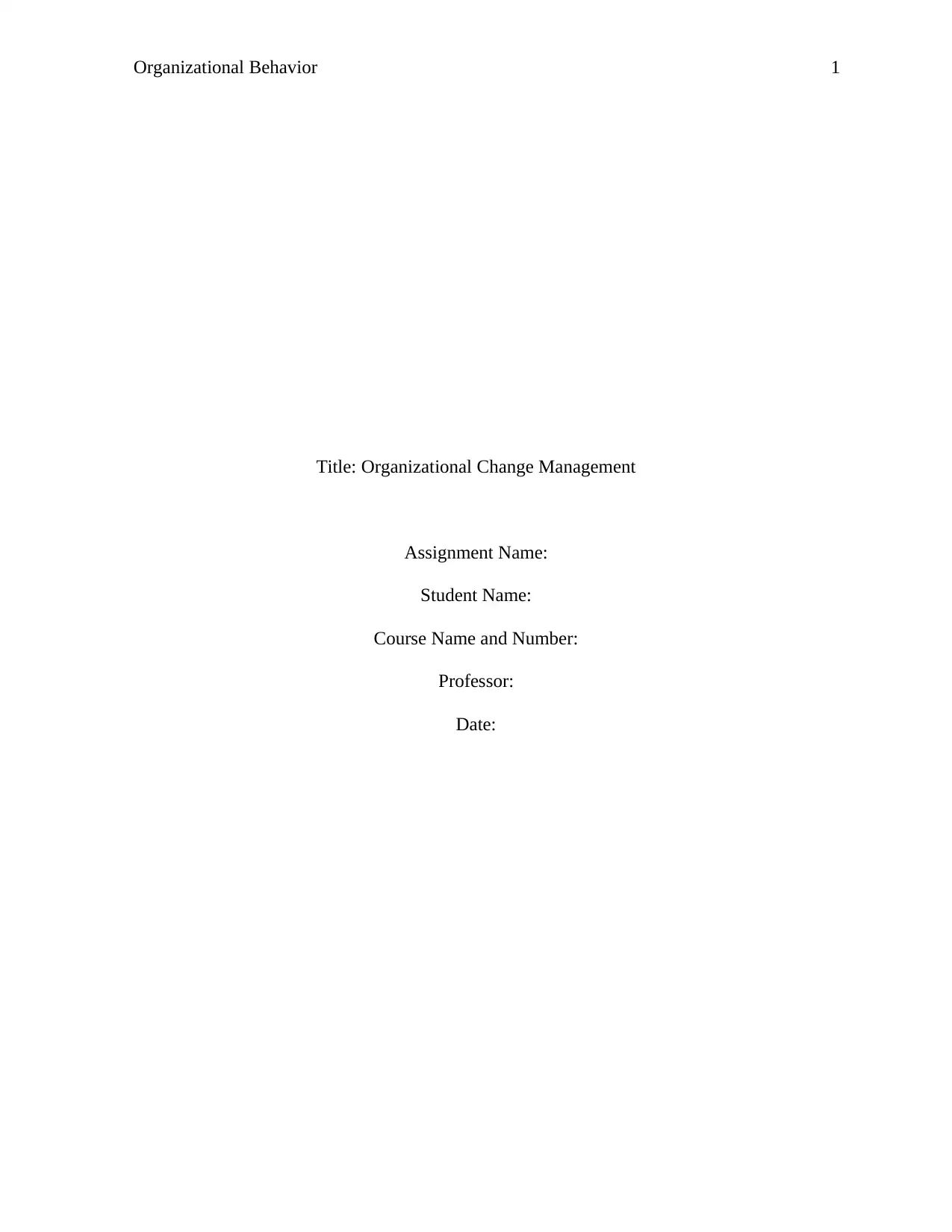
Organizational Behavior 1
Title: Organizational Change Management
Assignment Name:
Student Name:
Course Name and Number:
Professor:
Date:
Title: Organizational Change Management
Assignment Name:
Student Name:
Course Name and Number:
Professor:
Date:
Paraphrase This Document
Need a fresh take? Get an instant paraphrase of this document with our AI Paraphraser
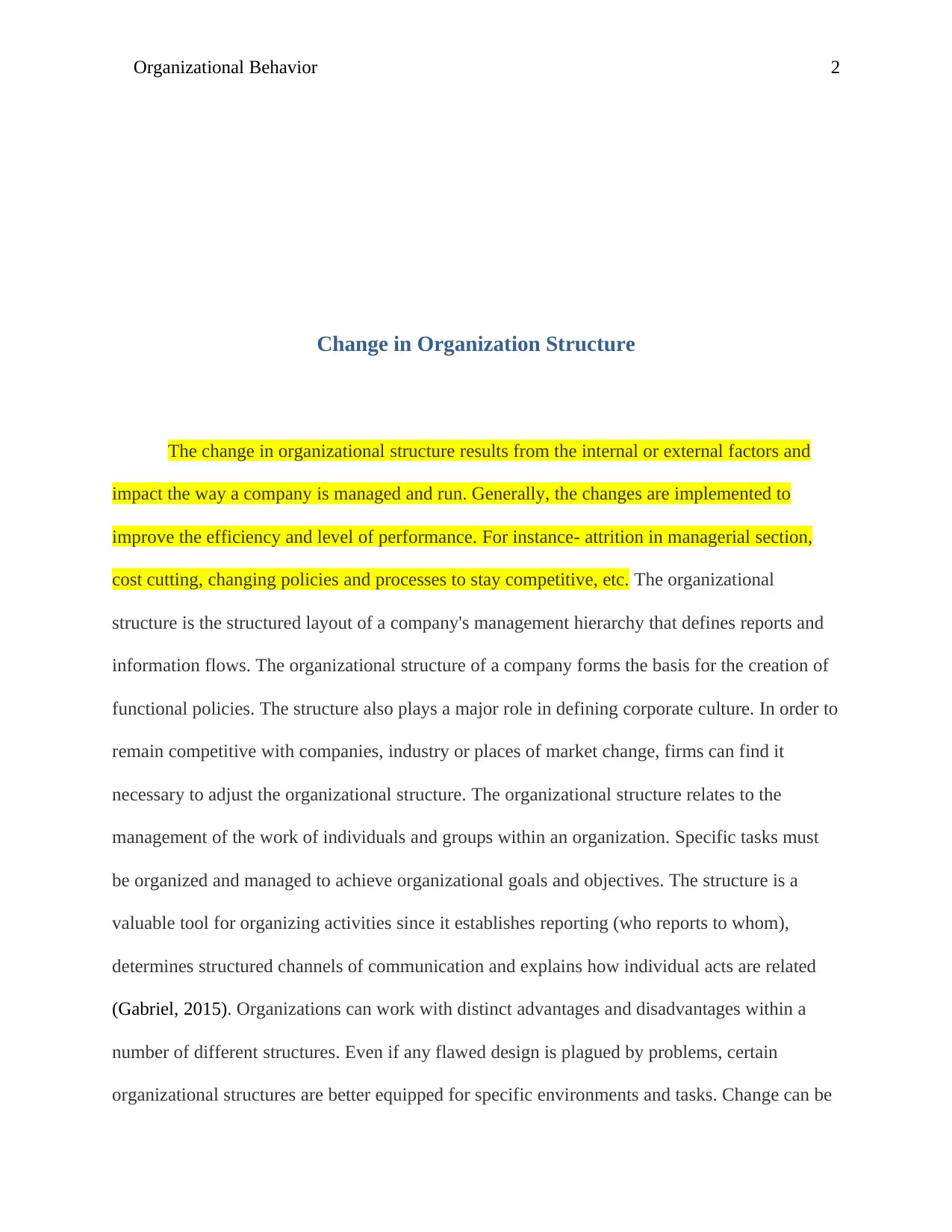
Organizational Behavior 2
Change in Organization Structure
The change in organizational structure results from the internal or external factors and
impact the way a company is managed and run. Generally, the changes are implemented to
improve the efficiency and level of performance. For instance- attrition in managerial section,
cost cutting, changing policies and processes to stay competitive, etc. The organizational
structure is the structured layout of a company's management hierarchy that defines reports and
information flows. The organizational structure of a company forms the basis for the creation of
functional policies. The structure also plays a major role in defining corporate culture. In order to
remain competitive with companies, industry or places of market change, firms can find it
necessary to adjust the organizational structure. The organizational structure relates to the
management of the work of individuals and groups within an organization. Specific tasks must
be organized and managed to achieve organizational goals and objectives. The structure is a
valuable tool for organizing activities since it establishes reporting (who reports to whom),
determines structured channels of communication and explains how individual acts are related
(Gabriel, 2015). Organizations can work with distinct advantages and disadvantages within a
number of different structures. Even if any flawed design is plagued by problems, certain
organizational structures are better equipped for specific environments and tasks. Change can be
Change in Organization Structure
The change in organizational structure results from the internal or external factors and
impact the way a company is managed and run. Generally, the changes are implemented to
improve the efficiency and level of performance. For instance- attrition in managerial section,
cost cutting, changing policies and processes to stay competitive, etc. The organizational
structure is the structured layout of a company's management hierarchy that defines reports and
information flows. The organizational structure of a company forms the basis for the creation of
functional policies. The structure also plays a major role in defining corporate culture. In order to
remain competitive with companies, industry or places of market change, firms can find it
necessary to adjust the organizational structure. The organizational structure relates to the
management of the work of individuals and groups within an organization. Specific tasks must
be organized and managed to achieve organizational goals and objectives. The structure is a
valuable tool for organizing activities since it establishes reporting (who reports to whom),
determines structured channels of communication and explains how individual acts are related
(Gabriel, 2015). Organizations can work with distinct advantages and disadvantages within a
number of different structures. Even if any flawed design is plagued by problems, certain
organizational structures are better equipped for specific environments and tasks. Change can be
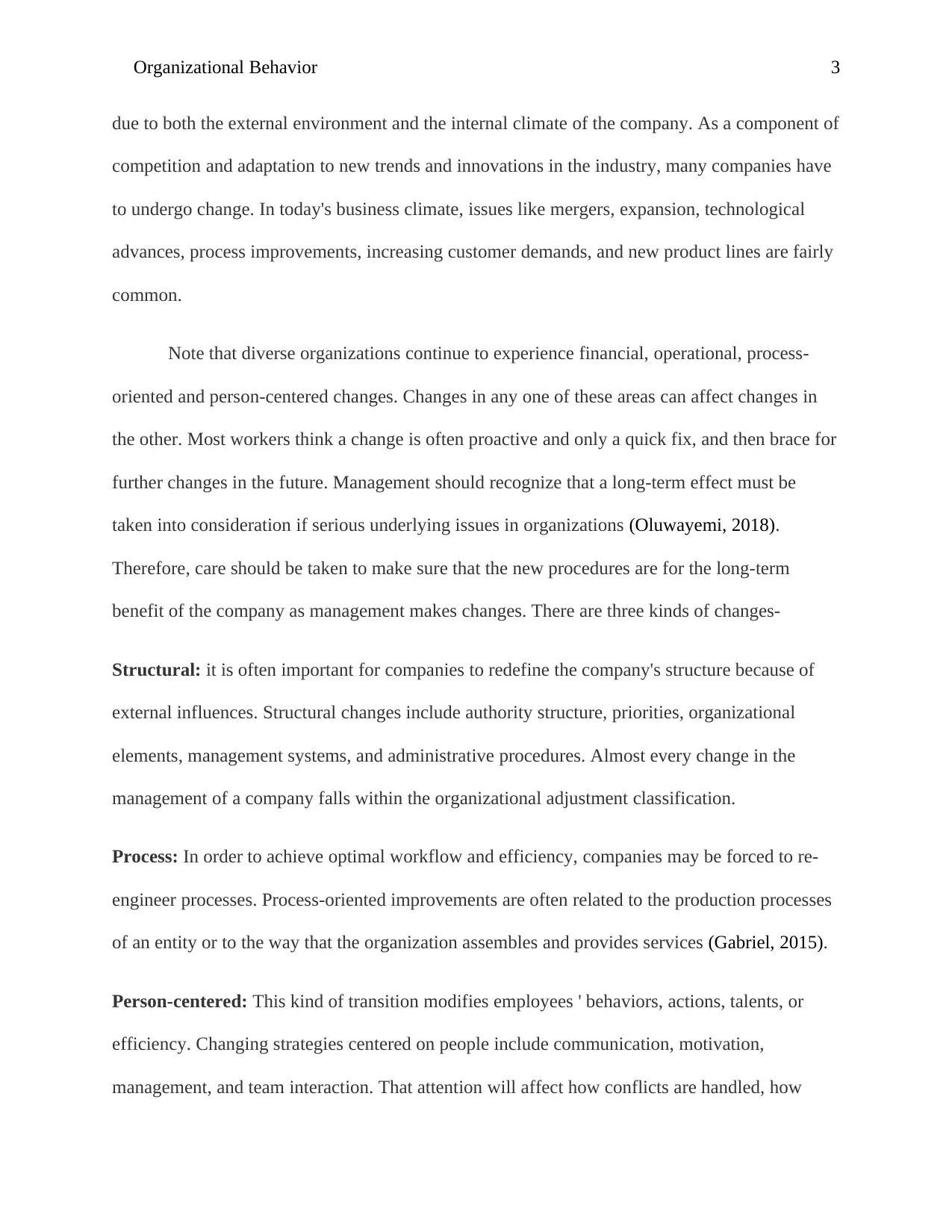
Organizational Behavior 3
due to both the external environment and the internal climate of the company. As a component of
competition and adaptation to new trends and innovations in the industry, many companies have
to undergo change. In today's business climate, issues like mergers, expansion, technological
advances, process improvements, increasing customer demands, and new product lines are fairly
common.
Note that diverse organizations continue to experience financial, operational, process-
oriented and person-centered changes. Changes in any one of these areas can affect changes in
the other. Most workers think a change is often proactive and only a quick fix, and then brace for
further changes in the future. Management should recognize that a long-term effect must be
taken into consideration if serious underlying issues in organizations (Oluwayemi, 2018).
Therefore, care should be taken to make sure that the new procedures are for the long-term
benefit of the company as management makes changes. There are three kinds of changes-
Structural: it is often important for companies to redefine the company's structure because of
external influences. Structural changes include authority structure, priorities, organizational
elements, management systems, and administrative procedures. Almost every change in the
management of a company falls within the organizational adjustment classification.
Process: In order to achieve optimal workflow and efficiency, companies may be forced to re-
engineer processes. Process-oriented improvements are often related to the production processes
of an entity or to the way that the organization assembles and provides services (Gabriel, 2015).
Person-centered: This kind of transition modifies employees ' behaviors, actions, talents, or
efficiency. Changing strategies centered on people include communication, motivation,
management, and team interaction. That attention will affect how conflicts are handled, how
due to both the external environment and the internal climate of the company. As a component of
competition and adaptation to new trends and innovations in the industry, many companies have
to undergo change. In today's business climate, issues like mergers, expansion, technological
advances, process improvements, increasing customer demands, and new product lines are fairly
common.
Note that diverse organizations continue to experience financial, operational, process-
oriented and person-centered changes. Changes in any one of these areas can affect changes in
the other. Most workers think a change is often proactive and only a quick fix, and then brace for
further changes in the future. Management should recognize that a long-term effect must be
taken into consideration if serious underlying issues in organizations (Oluwayemi, 2018).
Therefore, care should be taken to make sure that the new procedures are for the long-term
benefit of the company as management makes changes. There are three kinds of changes-
Structural: it is often important for companies to redefine the company's structure because of
external influences. Structural changes include authority structure, priorities, organizational
elements, management systems, and administrative procedures. Almost every change in the
management of a company falls within the organizational adjustment classification.
Process: In order to achieve optimal workflow and efficiency, companies may be forced to re-
engineer processes. Process-oriented improvements are often related to the production processes
of an entity or to the way that the organization assembles and provides services (Gabriel, 2015).
Person-centered: This kind of transition modifies employees ' behaviors, actions, talents, or
efficiency. Changing strategies centered on people include communication, motivation,
management, and team interaction. That attention will affect how conflicts are handled, how
⊘ This is a preview!⊘
Do you want full access?
Subscribe today to unlock all pages.

Trusted by 1+ million students worldwide
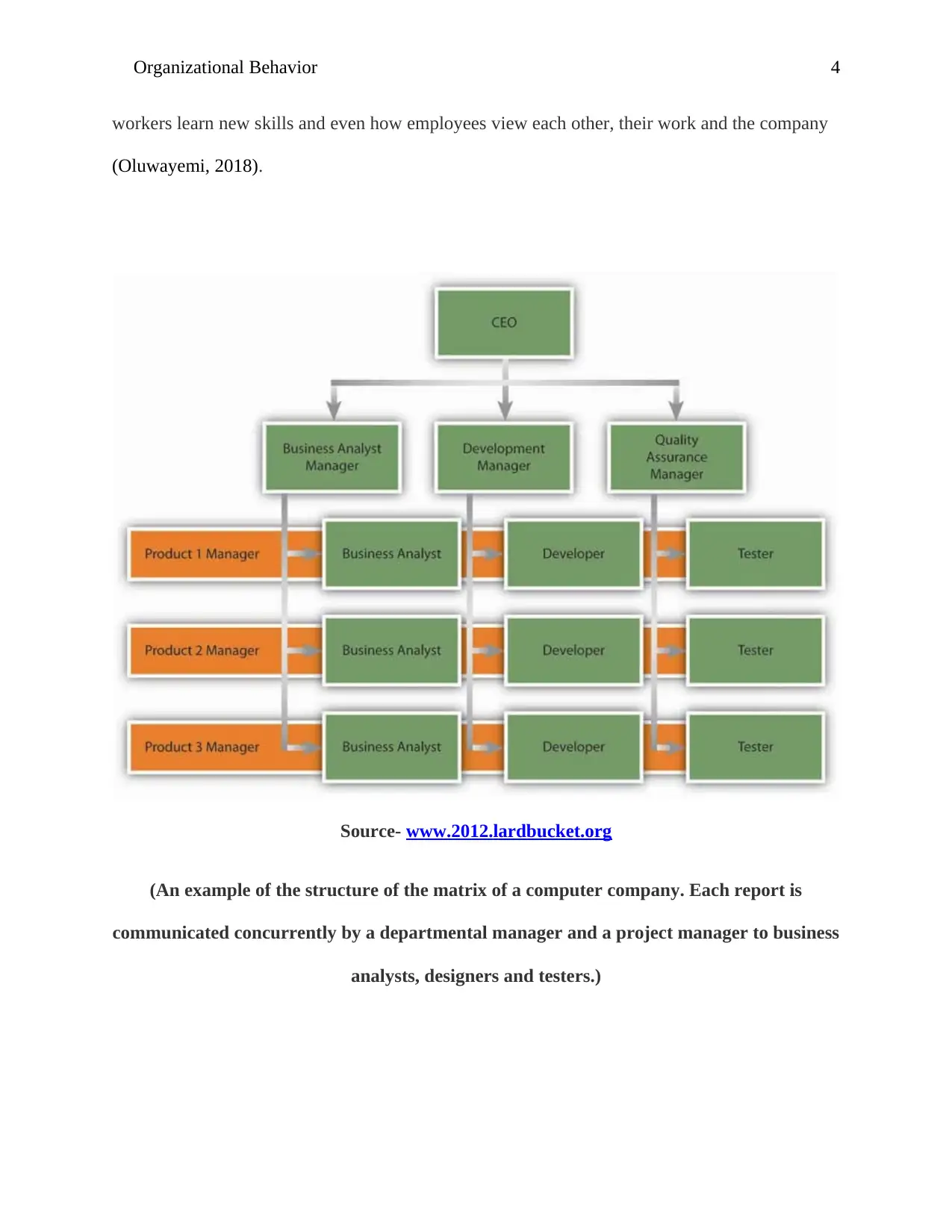
Organizational Behavior 4
workers learn new skills and even how employees view each other, their work and the company
(Oluwayemi, 2018).
Source- www.2012.lardbucket.org
(An example of the structure of the matrix of a computer company. Each report is
communicated concurrently by a departmental manager and a project manager to business
analysts, designers and testers.)
workers learn new skills and even how employees view each other, their work and the company
(Oluwayemi, 2018).
Source- www.2012.lardbucket.org
(An example of the structure of the matrix of a computer company. Each report is
communicated concurrently by a departmental manager and a project manager to business
analysts, designers and testers.)
Paraphrase This Document
Need a fresh take? Get an instant paraphrase of this document with our AI Paraphraser
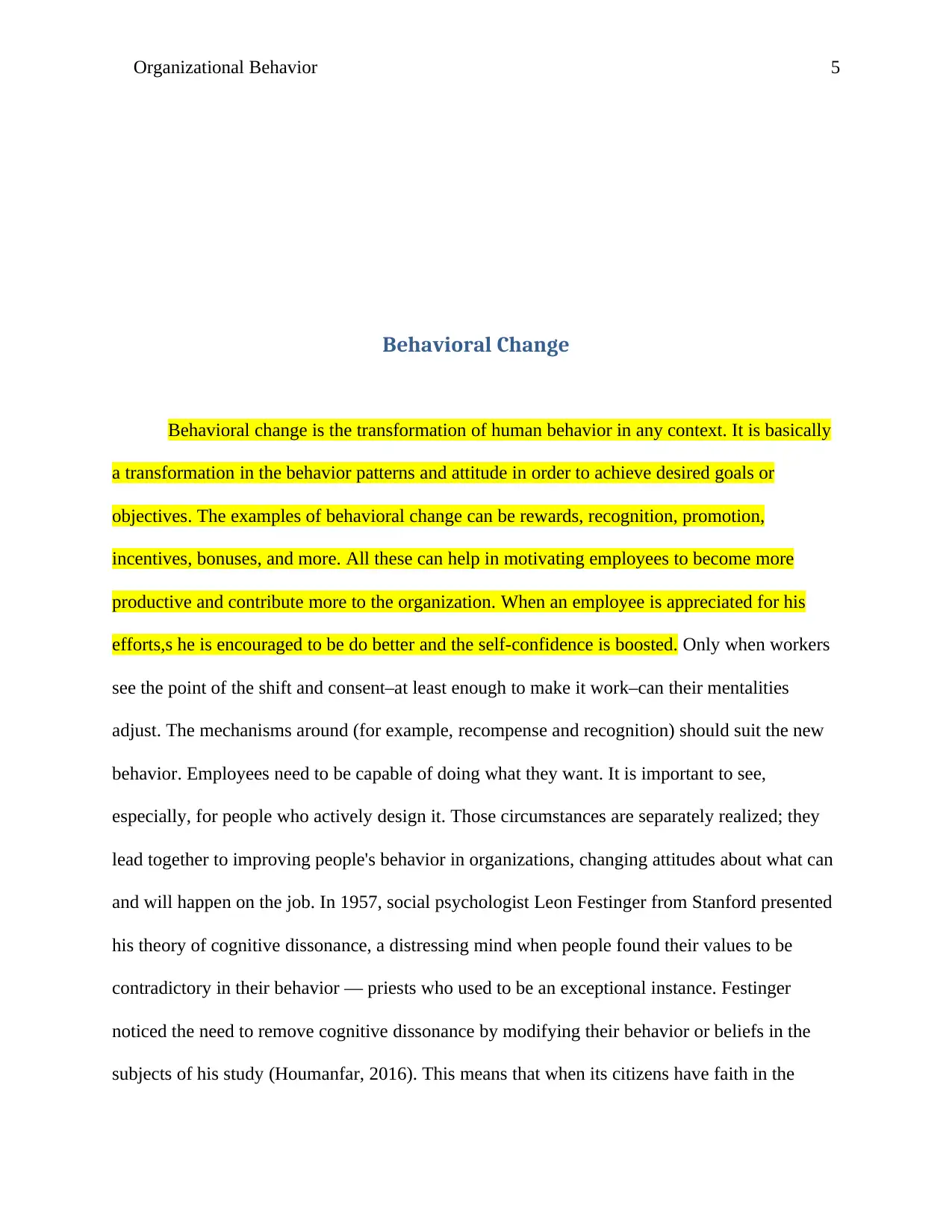
Organizational Behavior 5
Behavioral Change
Behavioral change is the transformation of human behavior in any context. It is basically
a transformation in the behavior patterns and attitude in order to achieve desired goals or
objectives. The examples of behavioral change can be rewards, recognition, promotion,
incentives, bonuses, and more. All these can help in motivating employees to become more
productive and contribute more to the organization. When an employee is appreciated for his
efforts,s he is encouraged to be do better and the self-confidence is boosted. Only when workers
see the point of the shift and consent–at least enough to make it work–can their mentalities
adjust. The mechanisms around (for example, recompense and recognition) should suit the new
behavior. Employees need to be capable of doing what they want. It is important to see,
especially, for people who actively design it. Those circumstances are separately realized; they
lead together to improving people's behavior in organizations, changing attitudes about what can
and will happen on the job. In 1957, social psychologist Leon Festinger from Stanford presented
his theory of cognitive dissonance, a distressing mind when people found their values to be
contradictory in their behavior — priests who used to be an exceptional instance. Festinger
noticed the need to remove cognitive dissonance by modifying their behavior or beliefs in the
subjects of his study (Houmanfar, 2016). This means that when its citizens have faith in the
Behavioral Change
Behavioral change is the transformation of human behavior in any context. It is basically
a transformation in the behavior patterns and attitude in order to achieve desired goals or
objectives. The examples of behavioral change can be rewards, recognition, promotion,
incentives, bonuses, and more. All these can help in motivating employees to become more
productive and contribute more to the organization. When an employee is appreciated for his
efforts,s he is encouraged to be do better and the self-confidence is boosted. Only when workers
see the point of the shift and consent–at least enough to make it work–can their mentalities
adjust. The mechanisms around (for example, recompense and recognition) should suit the new
behavior. Employees need to be capable of doing what they want. It is important to see,
especially, for people who actively design it. Those circumstances are separately realized; they
lead together to improving people's behavior in organizations, changing attitudes about what can
and will happen on the job. In 1957, social psychologist Leon Festinger from Stanford presented
his theory of cognitive dissonance, a distressing mind when people found their values to be
contradictory in their behavior — priests who used to be an exceptional instance. Festinger
noticed the need to remove cognitive dissonance by modifying their behavior or beliefs in the
subjects of his study (Houmanfar, 2016). This means that when its citizens have faith in the
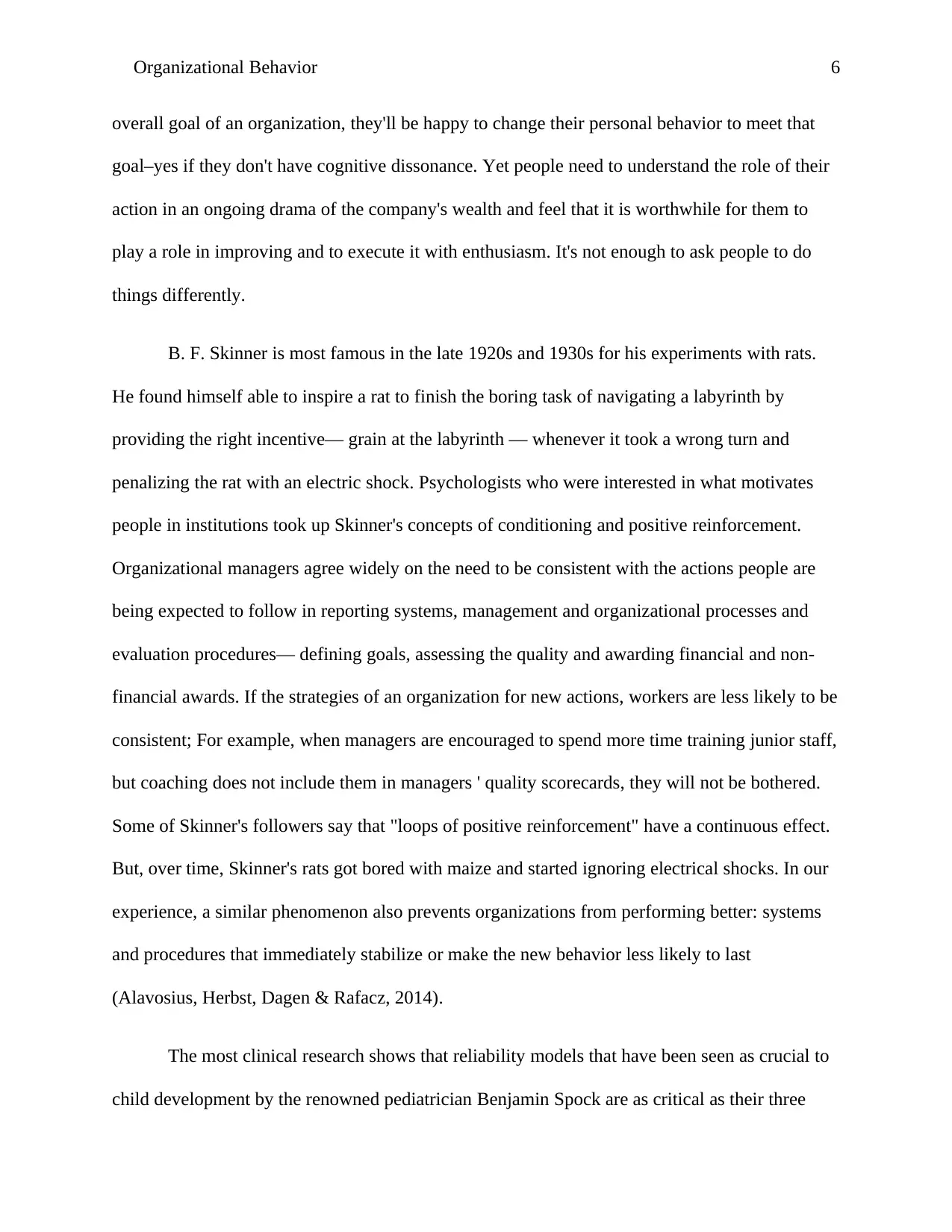
Organizational Behavior 6
overall goal of an organization, they'll be happy to change their personal behavior to meet that
goal–yes if they don't have cognitive dissonance. Yet people need to understand the role of their
action in an ongoing drama of the company's wealth and feel that it is worthwhile for them to
play a role in improving and to execute it with enthusiasm. It's not enough to ask people to do
things differently.
B. F. Skinner is most famous in the late 1920s and 1930s for his experiments with rats.
He found himself able to inspire a rat to finish the boring task of navigating a labyrinth by
providing the right incentive— grain at the labyrinth — whenever it took a wrong turn and
penalizing the rat with an electric shock. Psychologists who were interested in what motivates
people in institutions took up Skinner's concepts of conditioning and positive reinforcement.
Organizational managers agree widely on the need to be consistent with the actions people are
being expected to follow in reporting systems, management and organizational processes and
evaluation procedures— defining goals, assessing the quality and awarding financial and non-
financial awards. If the strategies of an organization for new actions, workers are less likely to be
consistent; For example, when managers are encouraged to spend more time training junior staff,
but coaching does not include them in managers ' quality scorecards, they will not be bothered.
Some of Skinner's followers say that "loops of positive reinforcement" have a continuous effect.
But, over time, Skinner's rats got bored with maize and started ignoring electrical shocks. In our
experience, a similar phenomenon also prevents organizations from performing better: systems
and procedures that immediately stabilize or make the new behavior less likely to last
(Alavosius, Herbst, Dagen & Rafacz, 2014).
The most clinical research shows that reliability models that have been seen as crucial to
child development by the renowned pediatrician Benjamin Spock are as critical as their three
overall goal of an organization, they'll be happy to change their personal behavior to meet that
goal–yes if they don't have cognitive dissonance. Yet people need to understand the role of their
action in an ongoing drama of the company's wealth and feel that it is worthwhile for them to
play a role in improving and to execute it with enthusiasm. It's not enough to ask people to do
things differently.
B. F. Skinner is most famous in the late 1920s and 1930s for his experiments with rats.
He found himself able to inspire a rat to finish the boring task of navigating a labyrinth by
providing the right incentive— grain at the labyrinth — whenever it took a wrong turn and
penalizing the rat with an electric shock. Psychologists who were interested in what motivates
people in institutions took up Skinner's concepts of conditioning and positive reinforcement.
Organizational managers agree widely on the need to be consistent with the actions people are
being expected to follow in reporting systems, management and organizational processes and
evaluation procedures— defining goals, assessing the quality and awarding financial and non-
financial awards. If the strategies of an organization for new actions, workers are less likely to be
consistent; For example, when managers are encouraged to spend more time training junior staff,
but coaching does not include them in managers ' quality scorecards, they will not be bothered.
Some of Skinner's followers say that "loops of positive reinforcement" have a continuous effect.
But, over time, Skinner's rats got bored with maize and started ignoring electrical shocks. In our
experience, a similar phenomenon also prevents organizations from performing better: systems
and procedures that immediately stabilize or make the new behavior less likely to last
(Alavosius, Herbst, Dagen & Rafacz, 2014).
The most clinical research shows that reliability models that have been seen as crucial to
child development by the renowned pediatrician Benjamin Spock are as critical as their three
⊘ This is a preview!⊘
Do you want full access?
Subscribe today to unlock all pages.

Trusted by 1+ million students worldwide
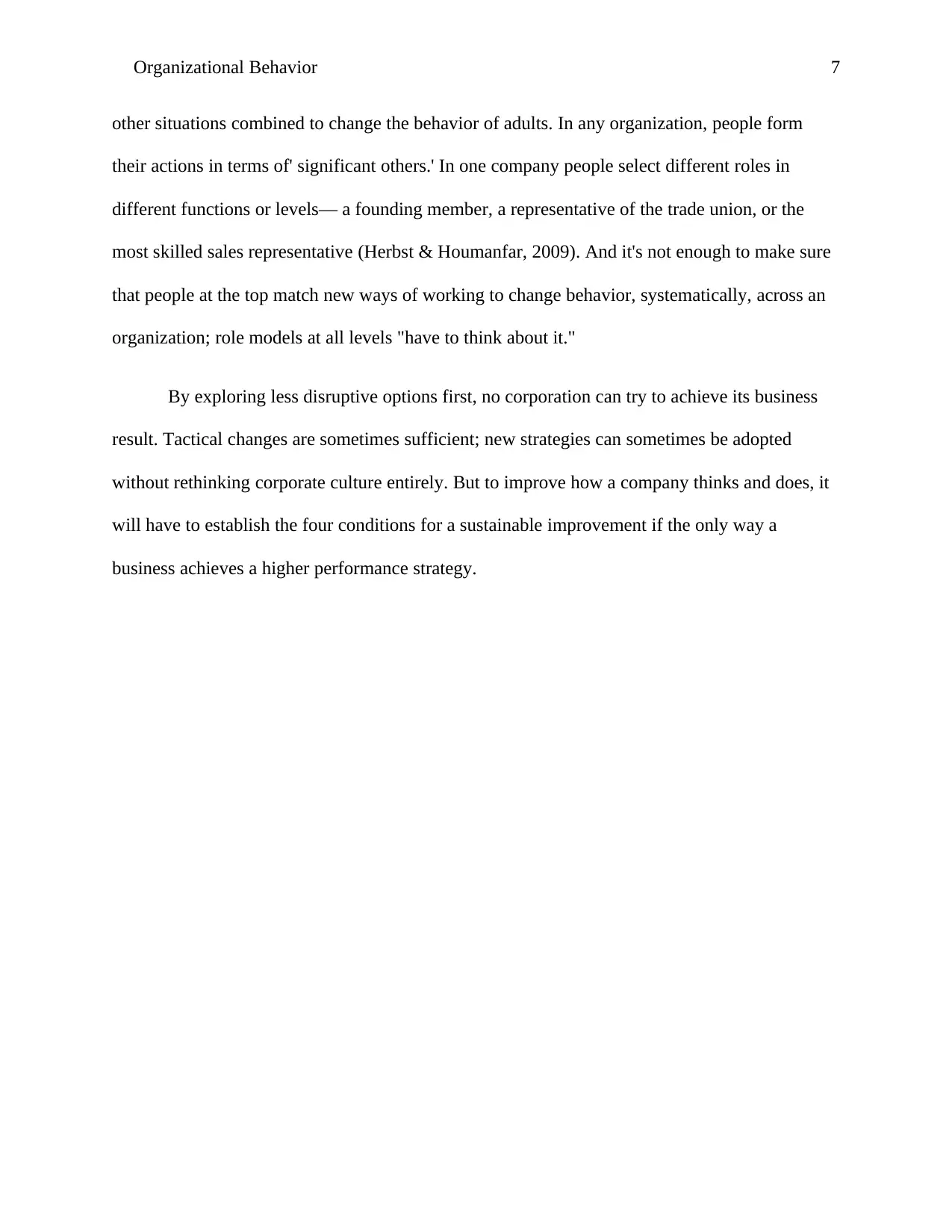
Organizational Behavior 7
other situations combined to change the behavior of adults. In any organization, people form
their actions in terms of' significant others.' In one company people select different roles in
different functions or levels— a founding member, a representative of the trade union, or the
most skilled sales representative (Herbst & Houmanfar, 2009). And it's not enough to make sure
that people at the top match new ways of working to change behavior, systematically, across an
organization; role models at all levels "have to think about it."
By exploring less disruptive options first, no corporation can try to achieve its business
result. Tactical changes are sometimes sufficient; new strategies can sometimes be adopted
without rethinking corporate culture entirely. But to improve how a company thinks and does, it
will have to establish the four conditions for a sustainable improvement if the only way a
business achieves a higher performance strategy.
other situations combined to change the behavior of adults. In any organization, people form
their actions in terms of' significant others.' In one company people select different roles in
different functions or levels— a founding member, a representative of the trade union, or the
most skilled sales representative (Herbst & Houmanfar, 2009). And it's not enough to make sure
that people at the top match new ways of working to change behavior, systematically, across an
organization; role models at all levels "have to think about it."
By exploring less disruptive options first, no corporation can try to achieve its business
result. Tactical changes are sometimes sufficient; new strategies can sometimes be adopted
without rethinking corporate culture entirely. But to improve how a company thinks and does, it
will have to establish the four conditions for a sustainable improvement if the only way a
business achieves a higher performance strategy.
Paraphrase This Document
Need a fresh take? Get an instant paraphrase of this document with our AI Paraphraser
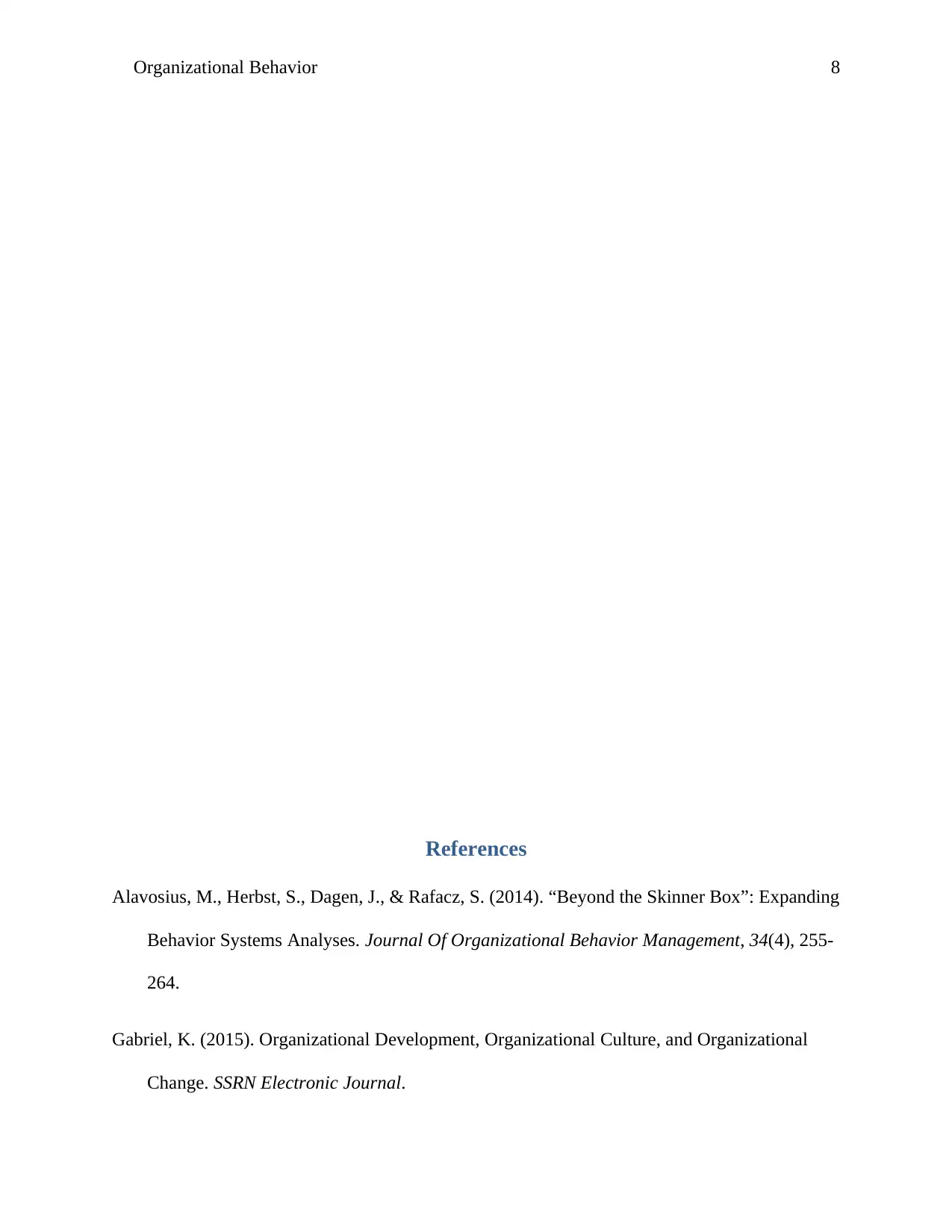
Organizational Behavior 8
References
Alavosius, M., Herbst, S., Dagen, J., & Rafacz, S. (2014). “Beyond the Skinner Box”: Expanding
Behavior Systems Analyses. Journal Of Organizational Behavior Management, 34(4), 255-
264.
Gabriel, K. (2015). Organizational Development, Organizational Culture, and Organizational
Change. SSRN Electronic Journal.
References
Alavosius, M., Herbst, S., Dagen, J., & Rafacz, S. (2014). “Beyond the Skinner Box”: Expanding
Behavior Systems Analyses. Journal Of Organizational Behavior Management, 34(4), 255-
264.
Gabriel, K. (2015). Organizational Development, Organizational Culture, and Organizational
Change. SSRN Electronic Journal.
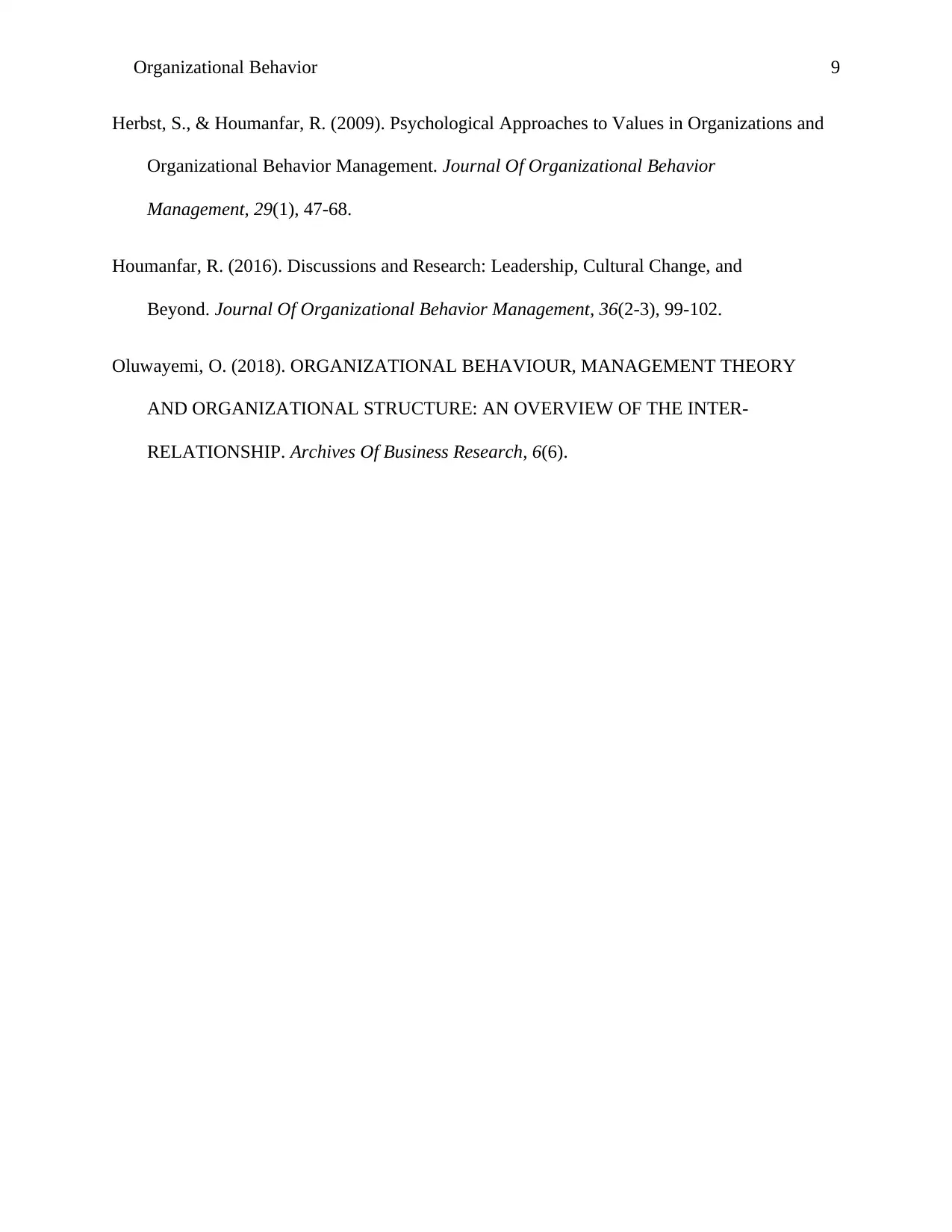
Organizational Behavior 9
Herbst, S., & Houmanfar, R. (2009). Psychological Approaches to Values in Organizations and
Organizational Behavior Management. Journal Of Organizational Behavior
Management, 29(1), 47-68.
Houmanfar, R. (2016). Discussions and Research: Leadership, Cultural Change, and
Beyond. Journal Of Organizational Behavior Management, 36(2-3), 99-102.
Oluwayemi, O. (2018). ORGANIZATIONAL BEHAVIOUR, MANAGEMENT THEORY
AND ORGANIZATIONAL STRUCTURE: AN OVERVIEW OF THE INTER-
RELATIONSHIP. Archives Of Business Research, 6(6).
Herbst, S., & Houmanfar, R. (2009). Psychological Approaches to Values in Organizations and
Organizational Behavior Management. Journal Of Organizational Behavior
Management, 29(1), 47-68.
Houmanfar, R. (2016). Discussions and Research: Leadership, Cultural Change, and
Beyond. Journal Of Organizational Behavior Management, 36(2-3), 99-102.
Oluwayemi, O. (2018). ORGANIZATIONAL BEHAVIOUR, MANAGEMENT THEORY
AND ORGANIZATIONAL STRUCTURE: AN OVERVIEW OF THE INTER-
RELATIONSHIP. Archives Of Business Research, 6(6).
⊘ This is a preview!⊘
Do you want full access?
Subscribe today to unlock all pages.

Trusted by 1+ million students worldwide
1 out of 9
Related Documents
Your All-in-One AI-Powered Toolkit for Academic Success.
+13062052269
info@desklib.com
Available 24*7 on WhatsApp / Email
![[object Object]](/_next/static/media/star-bottom.7253800d.svg)
Unlock your academic potential
Copyright © 2020–2025 A2Z Services. All Rights Reserved. Developed and managed by ZUCOL.



